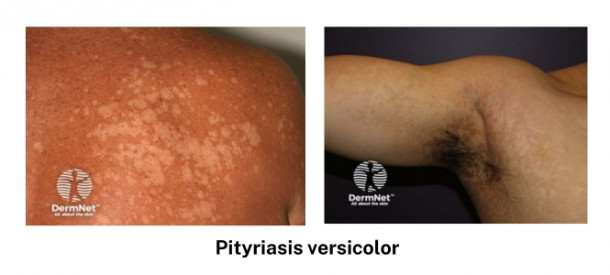Wishing everyone a safe and happy Christmas and New Year – Meri Kirihimete from the Healthify team.
Pityriasis versicolor
Key points about pityriasis versicolor
- Pityriasis versicolor is a common rash caused by a yeast.
- The rash looks like pale, pink or brown patches – usually on your chest and back.
- It's most common in teenagers and young adults.
- It can be treated with antifungal cream, or an antifungal shampoo that you rinse off after 10 minutes.

Overview
Pityriasis versicolor is a skin reaction to common yeast called Malassezia. Usually the yeast lives on your skin without it causing any problems. But sometimes it can grow and spread more than usual, especially if you're sweating and when oil glands in your skin are very active. The yeast makes chemicals that change the pigment your skin cells produce, causing patches of discoloured skin called pityriasis versicolor.
- Pityriasis versicolor is more common in hot, humid climates than in cool, dry climates.
- Pityriasis versicolor may be seasonal – it may clear up in the winter months and come back each summer.
- It often affects people who sweat more.
- It mostly affects young adults and adolescents but can also affect children and older adults.
- Although it's not considered infectious, it sometimes affects more than 1 member of a family.
The main symptom of pityriasis versicolor is discoloured spots or patches on your skin. For some people, it may cause a mild itch, scaling or irritation.
- On fair skin, the patches are usually pink, red or pale brown. The patches are no more likely to get sunburned than other skin, but you may notice the patches don't tan in the sun.
- On darker skin, the patches tend to be paler than the surrounding skin.
The patches can occur anywhere on your body but are most commonly seen on your neck, chest, back, and arms. You may also have dandruff which is caused by a similar yeast overgrowth on your scalp.
The images below show pityriasis versicolor on different skin tones.

Image credit: DermNet NZ(external link)
To diagnose pityriasis versicolour your healthcare provider will look at your skin for patches or spots.
In some cases, a special ultra-violet lamp can be used to look for yellow fluorescence which is typical of pityriasis versicolor. Sometimes your doctor may take skin scrapings to confirm the diagnosis. If there is any doubt, very occasionally, a small skin biopsy may be considered. This is where a small sample of skin is taken for testing.
The aim of treatment is to reduce the yeast living on the skin of the affected areas. It can take a few months for the skin to return to its usual colour after treatment. Sometimes the patches can come back, known as a recurrence.
Antifungal creams or shampoo
- For smaller areas, an antifungal cream may be applied once or twice daily for 1 to 4 weeks.
- For larger areas, a shampoo may be more suitable. Examples include ketoconazole (Nizoral, Sebizole, Ketopine) and selenium sulphide (Selsun). After wetting your skin, apply the shampoo to the affected area and leave it on for 10 minutes before washing off. This is to allow time for the active ingredient to get into your skin and hair follicles to reduce the yeast. Apply the shampoo once daily for 7 days then weekly for 1 month. It can be repeated if the symptoms reappear.
- If your rash is the same as pityriasis versicolor that's been diagnosed before by a doctor or nurse practitioner, it's safe to buy these treatments directly from your pharmacist.
Antifungal tablets or capsules
If pityriasis versicolor covers a large area, or shampoos and creams don't work, your healthcare provider may prescribe antifungal tablets or capsules. Exercising vigorously an hour after taking the medicine help it to work better by sweating it onto your skin where the yeast lives. Don't have a shower for a few hours.
What if the patches come back again?
The patches or spots of pityriasis versicolor often come back. Use of an antifungal shampoo once a month may reduce the chance of this happening.
References
- Karray M, McKinney WP. Tinea versicolor(external link) StatPearls, National Library of Medicines, US, 2024
- Pityriasis versicolor(external link) DermNet, NZ
Credits: Sandra Ponen, Pharmacist, Healthify He Puna Waiora. Healthify is brought to you by Health Navigator Charitable Trust.
Reviewed by: Angela Lambie, Pharmacist, Auckland; Dr Emma Dunning, Clinical Editor and Advisor
Last reviewed:





